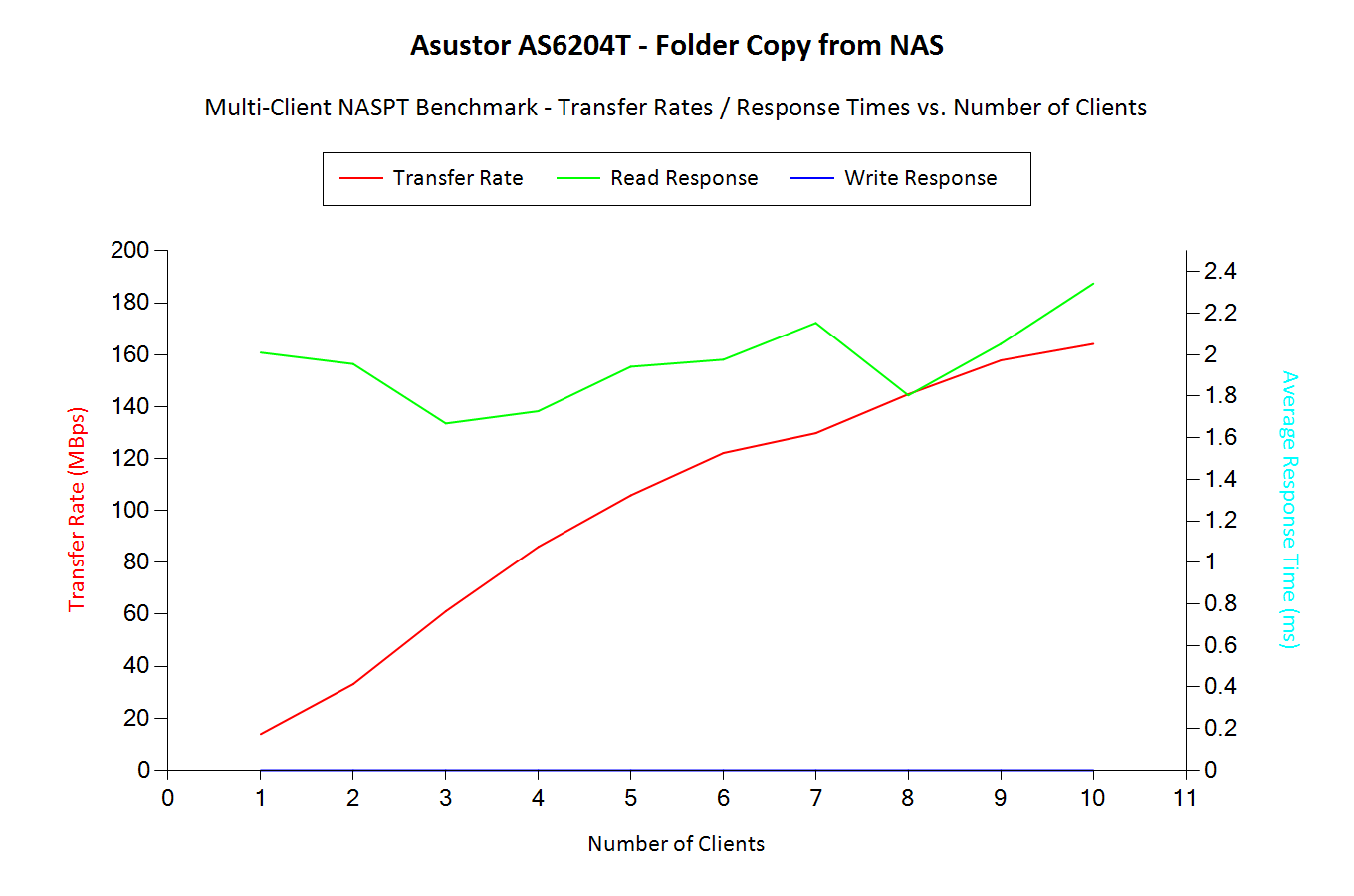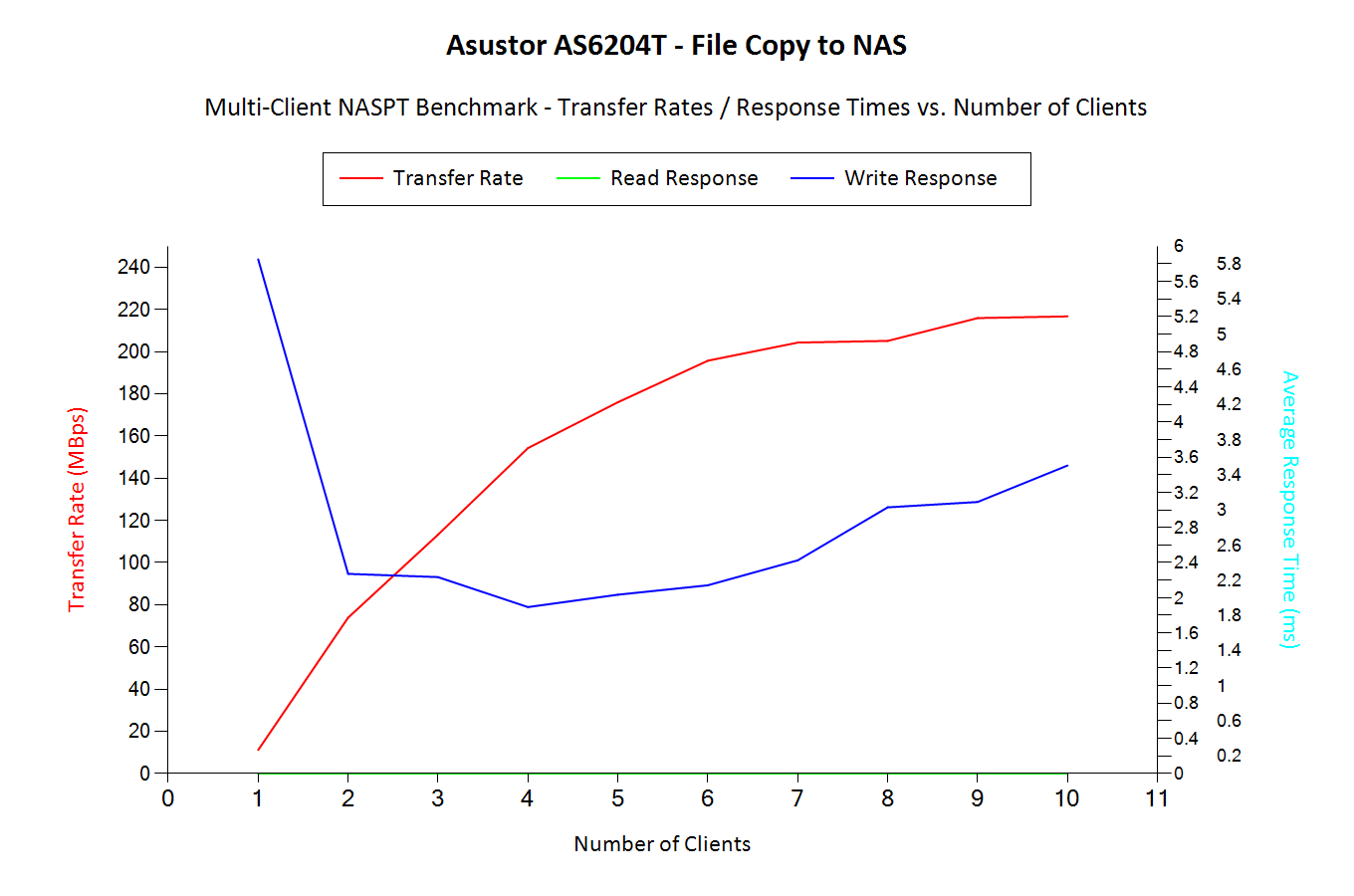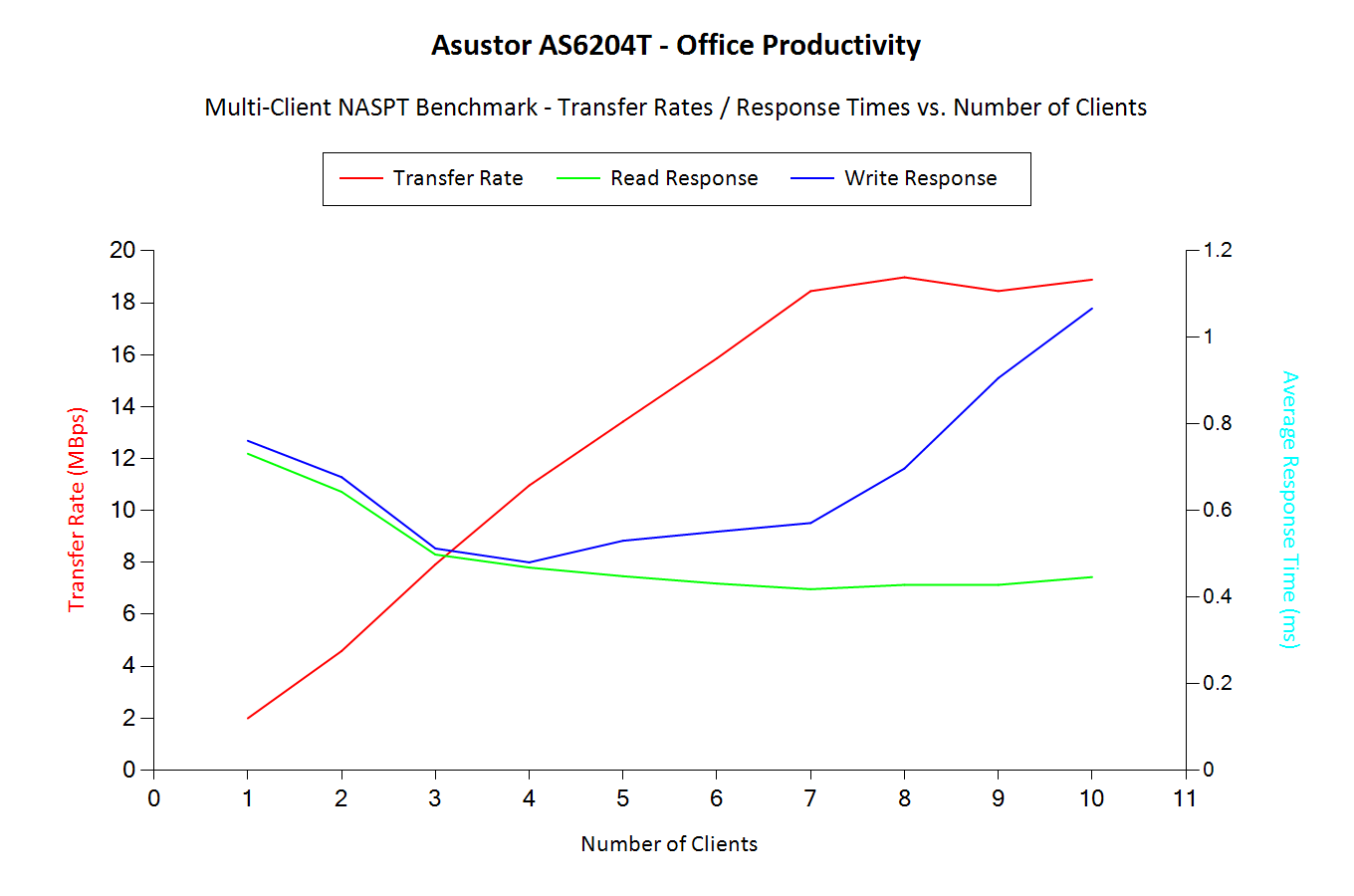Asustor AS6204T Braswell NAS Review
by Ganesh T S on November 5, 2015 8:00 AM ESTMulti-Client CIFS Performance for Consumer Workloads
The workloads experienced by a NAS unit in a typical home consumer setting have changed quite a bit over the last few years. Multiple mobile devices in a typical household raise the possibility that a NAS could be subject to the streaming out of multiple video files simultaneously. The popularity of IP cameras also make it necessary for NAS units to be able to record multiple video streams at the same time.
In our previous NAS reviews, we evaluated multi-client scenarios using synthetic workload traces and IOMeter. While there is nothing wrong in presenting numbers from such benchmarks, the reader is often left confused as to what those numbers might mean for his particular use-cases. Intel's NASPT benchmarking program gives us a good idea of the performance of the NAS unit when accessed by a single client. We took the source code of Intel's NASPT along with the supplied application traces and tweaked them to be able to run from more than one Windows client simultaneously in a co-ordinated manner. The graphs below present the results from tracking various metrics during the course of the benchmark runs. It must be noted that the average service times refer to what is obtained for all the traces when some of the data has already been cached in the client's memory. Unfortunately, NASPT doesn't provide any sort of guideline on what the optimal bandwidth and service times are for a good user experience.
Content Creation
The Content Creation workload seems to get acceptable performance for up to 5 clients. Beyond that, the per-client bandwidth numbers start to plateau / get worse, and the average response time also starts ramping up steeply. The drop-down at the bottom of the graph shows other comparison points. We find that the QNAP TS-451+ can support an additional client and provide better per-client bandwidth for the same workload. The detailed table with a breakdown of all the throughput numbers as well as the service times is available here

Folder Copy from NAS
The Folder Copy from NAS workload seems to get acceptable performance across the maximum number of clients that we tested (10). In this workload, we actually see that the AS6204T can perform better than the QNAP TS-451+. The detailed table with a breakdown of all the throughput numbers as well as the service times is available here

Folder Copy to NAS
The Folder Copy to NAS workload seems to get acceptable performance for up to 7 clients. Beyond that, we have a steep spike in the average response time. The QNAP TS-451+ performs better in this write-intensive workload. The detailed table with a breakdown of all the throughput numbers as well as the service times is available here

File Copy from NAS
The File Copy from NAS workload doesn't trouble the AS6204T. It gets acceptable performance across all tested clients (10). Unlike the QNAP TS-451+, the AS6204T is able to almost saturate the dual GbE links in this read-intensive workload. The detailed table with a breakdown of all the throughput numbers as well as the service times is available here

File Copy to NAS
The File Copy to NAS workload doesn't pose any problems to the AS6204T across the maximum number of clients we tested (10). The performance is actually neck-and-neck with the QNAP TS-451+ as we increase the number of clients. The detailed table with a breakdown of all the throughput numbers as well as the service times is available here

HD Video (1x) Playback
The HD Video (1x) Playback workload is read-intensive, and, as we have seen from previous workloads, the AS6204T is able to easily surpass the QNAP TS-451+ both in terms of nett bandwidth as well as lower average response times. In fact, a little bit of caching on the clients side actually enables apparent saturation of the network links. The detailed table with a breakdown of all the throughput numbers as well as the service times is available here
-Playback.png)
HD Video(1x) Playback and Record
The HD Video(1x) Playback and Record workload involves both reads and writes. The full-duplex nature of the network links enables the total bandwidth to be more than 300 MBps for this workload. Performance is better than the QNAP TS-451+ across all metrics for this workload. The detailed table with a breakdown of all the throughput numbers as well as the service times is available here
-Playback-and-Record.png)
HD Video (1x) Record
The HD Video (1x) Record workload fares similarly in both the AS6204T and the QNAP TS-451+. This write-intensive workload comes close to saturating the network links for both systems. The detailed table with a breakdown of all the throughput numbers as well as the service times is available here
-Record.png)
HD Video (2x) Playback
The HD Video (2x) Playback workload pulls the AS6204T ahead of the QNAP TS-451+ as the number of read streams increases. The network links are close to saturation in the Asustor case. The detailed table with a breakdown of all the throughput numbers as well as the service times is available here
-Playback.png)
HD Video (4x) Playback
The HD Video (4x) Playback workload behaves similar to the 2x playback workload. The AS6204T performs better than the QNAP TS-451+ in this case. The detailed table with a breakdown of all the throughput numbers as well as the service times is available here
-Playback.png)
Office Productivity
The Office Productivity workload seems to get acceptable performance for up to 7 clients. Beyond that, we have a noticeable drop in the per-client bandwidth numbers and a ramp in the response times. The QNAP TS-451+ is able to easily surpass the AS6204T in this IOPS intensive workload. The detailed table with a breakdown of all the throughput numbers as well as the service times is available here

Photo Album
The Photo Album workload seems to get similar performance for both the AS6204T as well as the QNAP TS-451+. All 10 clients seem to get acceptable performance. However, the average write response times for the AS6204T are a bit higher compared to the QNAP TS-451+. The detailed table with a breakdown of all the throughput numbers as well as the service times is available here

The detailed logs from the processing of our benchmarks - inclusive of metrics such as the file open times for each workload on each of the clients - can be found here










29 Comments
View All Comments
RdVi - Thursday, November 5, 2015 - link
It's hard to compare the graphs on page 4 when the values on the axis vary (sometimes wildly) between the two. Flicking back and forth it is very hard to easily compare on face value. Would it not be possible to have the scale locked to whichever graph approaches the highest value?ganeshts - Thursday, November 5, 2015 - link
The issue here is that these graphs are generated on a per-review basis - i.e, the graph that you see for the QNAP TS-451+ was generated at the time of writing the QNAP TS-451+ review. At that time, the Asustor AS6204T hadn't been evaluated, so it is not possible to know ahead of time what the highest value is going to be.I think we have the best possible solution here in the timeframe that can be devoted to the review - the other solution is to simply not have any graphs for the competing units (similar to what we did for the QNAP TS-451+ review which was the first 4-bay one done with the new methodology).
DanNeely - Friday, November 6, 2015 - link
Are the graphs coming from the bench software itself? If there is a CSV export option generating combined comparison graphs (or rescaled stand alone ones) shouldn't be hard to do after the fact.ganeshts - Friday, November 6, 2015 - link
The bench software is written by me :) (except for the core trace replay component which is compiled from NASPT source). And, yes, the graphs are generated at the end of each benchmark run by my code.I don't have a CSV export option in the software yet, as I only export the HTML tables that are linked above each graph. So, yes, the data is there, but not in a format suitable for reprocessing with each new NAS run.
It is possible to implement CSV export and graph regeneration, but it is a matter of how much time I can spend to get the new code up and running. At this moment, I think the time cost far outweighs the benefits provided. I am currently working on optimizing our SPEC SFS testbed and benchmarking - I think that will provide more benefits to readers in the long run.
Oyster - Friday, November 6, 2015 - link
Ganesh, I mentioned this in some of your other NAS reviews. You need to review the software side of these vendors now. Would be awesome to see the biggies go head to head... Synology, QNAP, ASUS, and Lenovo. Please try to cover app offerings to other items like backdooring via SSH, etc.As usual, keep up the good work.
ganeshts - Friday, November 6, 2015 - link
Yes, it is in the works. The problem is that these are 'subjective' aspects and require more effort to use and record observations compared to objective benchmarking.MrElectrifyer - Saturday, November 7, 2015 - link
Curious how this compares to a QNAP TS-470 Pro...MrElectrifyer - Saturday, November 7, 2015 - link
So far, I know the TS-470 Pro can support more than 8GB of RAM...I upgraded mine to 10GB.WatcherCK - Monday, November 9, 2015 - link
Looks like disks get formatted internally to Ext4... The full specifications link seems to point back to the articles initial page was this by design? The full spec pdf for this NAS can be found here: http://www.asustor.com/service/resource?type=3&... (for a laugh check out what the display on the NAS is saying on its Asustor page, what do you know Asus? :) )Anyone considering a DIY NAS should checkout the new Asrock Rack C236 WSI that combined with a Silverstone DS380 would make for a powerful little storage box/virtualization server... They dont seem to be available anywhere yet unfortunately and Supermicro only have MATX C236 motherboards.